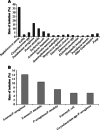Bacterial isolates from infected wounds and their antibiotic susceptibility pattern: some remarks about wound infection
- PMID: 23433007
- PMCID: PMC7950398
- DOI: 10.1111/iwj.12049
Bacterial isolates from infected wounds and their antibiotic susceptibility pattern: some remarks about wound infection
Abstract
Wound infection plays an important role in the development of chronicity, delaying wound healing. This study aimed to identify the bacterial pathogens present in infected wounds and characterise their resistance profile to the most common antibiotics used in therapy. Three hundred and twelve wound swab samples were collected from 213 patients and analysed for the identification of microorganisms and for the determination of their antibiotic susceptibility. Patients with diverse type of wounds were included in this retrospective study, carried out from March to September 2012. A total of 28 species were isolated from 217 infected wounds. The most common bacterial species detected was Staphylococcus aureus (37%), followed by Pseudomonas aeruginosa (17%), Proteus mirabilis (10%), Escherichia coli (6%) and Corynebacterium spp. (5%). Polymicrobial infection was found in 59 (27·1%) of the samples and was mainly constituted with two species. The most common association was S. aureus/P. aeruginosa. All Gram-positives were susceptible to vancomycin and linezolid. Gram-negatives showed quite high resistance to the majority of antibiotics, being amikacin the most active against these bacteria. This study is mostly oriented to health care practitioners who deal with wound management, making them aware about the importance of wound infection and helping them to choose the adequate treatment options to control microbial infection in wounds.
Keywords: Antibiotic susceptibility; Gram-positive and Gram-negative bacteria; Resistance pattern; Wound infection.
© 2013 The Authors. International Wound Journal © 2013 Medicalhelplines.com Inc and John Wiley & Sons Ltd.
Figures

References
-
- Meaume S, Keriheul JC, Fromantin I, Téot L. Workload and prevalence of open wounds in the community: French Vulnus initiative. J Wound Care 2012;21:62–6. - PubMed
-
- Cooper R, Lawrence JC. The isolation and identification of bacteria from wounds. J Wound Care 1996;5:335–40. - PubMed
-
- White RJ, Cooper R, Kingsley A. Wound colonization and infection: the role of topical antimicrobials. Br J Nurs 2001;10:563–78. - PubMed
-
- Edwards R, Harding KG. Bacteria and wound healing. Curr Opin Infect Dis 2004;17:91–6. - PubMed
MeSH terms
Substances
LinkOut - more resources
Full Text Sources
Other Literature Sources
Medical
Miscellaneous

